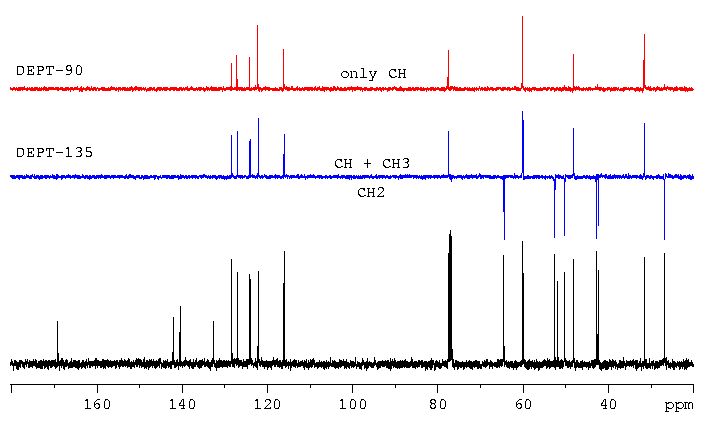|
|
The DEPT (Distortionless Enhancement by Polarization Transfer) experiment was designed to improve the sensitivity of NMR experiments on low-abundant and low magnetogyric ratio nuclei, X , such as 13C or 15N. The net effect is the non-selective polarizarion transfer from protons to X nuclei with the appropriate 1H-X coupling. Presently, DEPT experiments are largely used to determine carbon multiplicities.REQUIREMENTS
Easy implementation on AVANCE spectrometerVERSIONS
The basic DEPT pulse sequence ( 81JACS4603 , 82JMR323-48 , 82JCP2745 , and 83JMR272-53 ) consists of the following steps (see DEPT block):EXPERIMENTAL DETAILS
- Relaxation period (d1) to achieve a pre-equilibrium state.
- 90º 1H pulse (p1) to create transverse 1H magnetization (Iy).
- An evolution delay optimized to 1/2*J(XH) to achieve antiphase proton amgnetization (IxSz).
- Simultaneous 180º 1H and 90 X pulses. The proton pulse will allow to refocus 1H chemical shift evolution while the carbon pulse creates multiple quantum coherences.
- During a second delay (also optimized to 1/2*J(XH)) heteronuclear coupling is not evolving.
- Simultaneous Yº 1H and 90 X pulses. The carbon pulse refocus 13C chemical shift evolution while the Y proton pulse creates a different functional dependence as a function of carbon multiplicity:
Modified DEPT sequences:
CH 2IzSysin(Y)
CH2 4IzI´zSysin(Y)cos(Y)
CH3 8IzI´zI´´zSysin(Y)cos2(Y)
- A final evolution delay (also optimized to 1/2*J(XH)) to achieve in-phase 13C magnetization.
- 13C acquisition is performed under broadband proton decoupling.
- 1H-coupled DEPT spectra can be obtained under the same consitions if the proton decoupling is not applied. The last evolution period can also be omitted if antiphase multiplets are required. A particular experiment is the DEPT++ experiment.
- Use of composite pulses or adiabatic pulses
- By incorporating a variable evolution period in the defocusing period, 2D DEPT-based HETCOR experiment results.
- A reverse DEPT sequence ( 83JMR520-51 ). Starting from X nuclei, magnetization is transferred to 1H nuclei. The result is the acquisition of the satellites 1H-13C resonances and the suppression by means of phase cycling of the large unwanted central 1H-12C resonance. This block is referred as retro-DEPT building block in many multidimensional experiments.
- Compensated DEPT sequences over a range of 1J(XH) values ( 91JMR45-92 ).
- A DEPTQ pulse sequence to observe quaternary carbons ( 98JMR529-135 ).
The DEPT experiments are usually recorded in a fully automated way. Minor changes from a predefined parameter set are required. Only the flip angle of the last 1H pulse must be set according to the multiplicity-edited selection.
Some theoretical enhancement factors for NOE and DEPT(INEPT) experiments
with X{1H} pais of nuclei:
|
|
|
|
|
|
|
|
|
|
183W
|
|
|
2.56
|
2.99
|
-3.94
|
-1.52
|
16.48
|
-16.89
|
-9.75
|
-0.41
|
13.02
|
|
|
3.12
|
3.98
|
9.87
|
5.03
|
30.95
|
31.77
|
21.50
|
2.81
|
24.04
|
The DEPT experiment affords a 1H-decoupled 13C spectrum in which the intensity of X resonances depends on the flip angle of the last 1H pulse.RELATED TOPICS
- With a 45º pulse, all protonated carbon resonances appear with positive intensity.
- With a 90º pulse, only CH systems will be displayed.
With a 135º pulse, CH and CH3 groups appear positive while CH2 are negative.
See DEPT Spectra
Similar polarization transfer effects is achieved using the 1D INEPT pulse train, and other sequences have been also used for 13C-multiplicity editing purposes